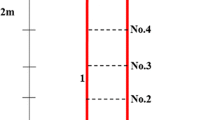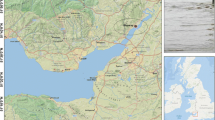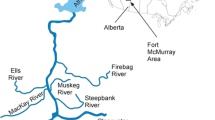Abstract
Purpose
Instruments able to measure the settling velocity distribution (SVD) and investigate the flocculation behavior of suspensions for a wide range of concentrations and settling regimes are required to understand and model sediment transport in headwater catchments. Such knowledge will improve our water resource management capabilities.
Materials and methods
An optical settling column, equipped with a vertical array of optical sensors, was used to provide light transmission through a suspension during quiescent settling. A new method to determine the settling velocity and the propensity of suspensions to flocculate is proposed. Its reliability was evaluated based on settling tests for (1) noncohesive sediments, (2) cohesive sediments at medium (~1 g l−1) concentration in a natural and deflocculated state, and (3) a cohesive sediment at a very high concentration (~10 g l−1). This choice of sediments and concentrations allowed for the assessment of free, flocculated, and hindered settling regimes.
Results and discussion
The proposed data processing method provides measurements for a range of test conditions. The result showed that different populations of particles with different settling behaviors can be identified within the suspensions. In the case of noncohesive sediments, the proposed method provided SVD similar to those obtained with reference methods. The propensity to flocculate was zero as expected for inert material. The natural cohesive sediment at medium concentration exhibited a large range of SVD (10−2–10−5 m s−1) and high propensity to flocculate. These were both reduced with the addition of a deflocculant. Identified particle behaviors were consistent with independent measurement of size distribution, microscopic, and erosion properties. In the hindered regime, a narrow SVD corresponded to the hindered front settling velocity (~10−4 m s−1).
Conclusions
An optical settling column was able to provide reliable SVD and an evaluation of the propensity of particles to flocculate. The settling column was able to detect variations of the settling velocities with settled depth, thus highlighting that settling columns with a single measurement point may provide erroneous results by not accounting for the full spectrum of settling depth.








Similar content being viewed by others
References
Agrawal YC, Pottsmith HC (2000) Instruments for particle size and settling velocity observations in sediment transport. Mar Geol 168:89–114
Andrews S, Nover D, Schladow SG (2010) Using laser diffraction data to obtain accurate particle size distributions: the role of particle composition. Limnol Oceanogr Methods 8:507–526
Antoine G (2013) Dynamique des matériaux en suspension le long de rivièeres aménagées de montagne. Exemple de l’Arc en Maurienne et de l’Isère. Université de Grenoble
Bale AJ (1996) In situ laser optical particle sizing. J Sea Res 36:31–36
Camenen B (2007) Simple and general formula for the settling velocity of particles. J Hydraul Eng 133:229–233
Camenen B, Pham Van Bang D (2011) Modelling the settling of suspended sediments for concentrations close to the gelling concentration. Cont Shelf Res 31:S106–S116
Camenen B, Jodeau M, Le Coz J (2008) Modélisation du flux sédimentaire pendant une chasse hydraulique (Arc en Maurienne). Houille Blanche 4:83–89
Carson M (1990) Evaluation of sediment data for the lower Athabasca River basin Alberta. Calgary, Alberta. Water Resources Branch Inland Water Directorate, Environment Canada, Calgary
Clifford N, Richards K, Brown R, Lane S (1995) Laboratory and field assessment of an infrared turbidity probe and its response to particle-size and variation in suspended sediment concentration. Hydrol Sci J-J Sci Hydrol 40:771–791
van de Hulst HC (1957) Light scattering by small particles. Wiley, New York
Donohue I, Garcia Molinos J (2009) Impacts of increased sediment loads on the ecology of lakes. Biol Rev 84:517–531
Downing J (2006) Twenty-five years with OBS sensors: the good, the bad, and the ugly. Cont Shelf Res 26:2299–2318
Droppo IG (2001) Rethinking what constitutes suspended sediment. Hydrol Process 15:1551–1564
Droppo IG (2004) Structural controls on floc strength and transport. Can J Civ Eng 31:569–578
Droppo IG, Leppard GG, Flannigan DT, Liss SN (1997) The freshwater gloc: a functional relationship of water and organic and inorganic floc constituents affecting suspended sediment properties. Water Air Soil Pollut 99:43–54
Droppo IG, D’Andrea L, Krishnappan BG, Jaskot C, Trapp B, Basuvaraj M, Liss SN (2015) Fine-sediment dynamics: towards an improved understanding of sediment erosion and transport. J Soils Sediments 15:467–479
Dyer KR (1989) Sediment processes in estuaries: future research requirements. J Geophys Res Oceans 1978–2012 94:14327–14339
Environment Canada (2011) Lower Athabasca water quality monitoring plan phase 1 (catalogue no. En14-42/2011E-PDF). ISBN 978-1-100-18471-5 http://www.ec.gc.ca/Content/8/A/1/8A1AB11A-1AA6-4E12-9373-60CF8CF98C76/WQMP_ENG.pdf
Fugate DC, Friedrichs CT (2002) Determining concentration and fall velocity of estuarine particle populations using ADV, OBS and LISST. Cont Shelf Res 22:1867–1886
Garcia-Aragon J, Droppo IG, Krishnappan B, Trapp B, Jaskot C (2011a) Experimental assessment of Athabasca River cohesive sediment deposition dynamics. Water Qual Res J Can 46:87–96
Garcia-Aragon J, Droppo IG, Krishnappan BG, Trapp B, Jaskot C (2011b) Erosion characteristics and floc strength of Athabasca River cohesive sediments: towards managing sediment-related issues. J Soils Sediments 11:679–689
Graham GW, Davies EJ, Nimmo-Smith WAM, Bowers DG, Braithwaite KM (2012) Interpreting LISST-100X measurements of particles with complex shape using digital in-line holography. J Geophys Res Oceans 117:C05034
Grangeon T, Legout C, Esteves M, Gratiot N, Navratil O (2012) Variability of the particle size of suspended sediment during highly concentrated flood events in a small mountainous catchment. J Soils Sediments 12:1549–1558
Gratiot N, Manning AJ (2004) An experimental investigation of floc characteristics in a diffusive turbulent flow. J Coast Res SI(41):105–113
Gratiot N, Michallet H, Mory M (2005) On the determination of the settling flux of cohesive sediments in a turbulent fluid. J Geophys Res 110:C06004
Huebner R (2011) Proposed retrofit for sediment settling velocity tubes (SVTs). Geochem J 45:417–419
Kemp P, Sear D, Collins A, Naden P, Jones I (2011) The impacts of fine sediment on riverine fish. Hydrol Process 25:1800–1821
Kynch GJ (1952) A theory of sedimentation. Trans Faraday Soc 48:166–176
Maerz J, Verney R, Wirtz K, Feudel U (2011) Modeling flocculation processes: Intercomparison of a size class-based model and a distribution-based model. Cont Shelf Res 31:S84–S93
Malarkey J, Jago CF, Hübner R, Jones SE (2013) A simple method to determine the settling velocity distribution from settling velocity tubes. Cont Shelf Res 56:82–89
Manning AJ, Dyer KR (2002) The use of optics for the in situ determination of flocculated mud characteristics. J Opt Pure Appl Opt 4:S71–S82
Mantovanelli A, Ridd PV (2006) Devices to measure settling velocities of cohesive sediment aggregates: a review of the in situ technology. J Sea Res 56:199–226
Mantovanelli A, Ridd PV (2008) SEDVEL: An underwater balance for measuring in situ settling velocities and suspended cohesive sediment concentrations. J Sea Res 60:235–245
Merten GH, Capel PD, Minella JPG (2014) Effects of suspended sediment concentration and grain size on three optical turbidity sensors. J Soils Sediments 14:1235–1241
Murray PB, McCave IN, Owen TRE, Mason M, Green MO (1996) A robust in situ settling velocity box for coastal seas. J Sea Res 36:101–107
Navratil O, Evrard O, Esteves M, Legout C, Ayrault S, Némery J, Mate-Marin A, Ahmadi M, Lefèvre I, Poirel A et al (2012) Temporal variability of suspended sediment sources in an alpine catchment combining river/rainfall monitoring and sediment fingerprinting. Earth Surf Process Landf 37:828–846
Owen MW (1976) Determination of the settling velocities of cohesive muds. Hydraulic Research Station, Wallingford
Phillips JM, Walling DE (2005) Intra-storm and seasonal variations in the effective particle size characteristics and effective particle density of fluvial suspended sediment in the Exe Basin, Devon, United Kingdom. In: Droppo IG, Leppard GG, Liss SN, Milligan TM (eds) Flocculation in natural and engineered environmental systems. CRC Press, Boca Raton, pp 47–70
Piro P, Carbone M, Tomei G (2010) Assessing settleability of dry and wet weather flows in an urban area serviced by combined sewers. Water Air Soil Pollut 214:107–117
Piro P, Carbone M, Penna N, Marsalek J (2011) Characterization of the settling process for wastewater from a combined sewer system. Water Res 45:6615–6624
Prowse TD (1993) Suspended sediment concentration during river ice breakup. Can J Civ Eng 20:872–875
Rovira A, Ballinger R, Ibáñez C, Parker P, Dominguez MD, Simon X, Lewandowski A, Hochfeld B, Tudor M, Vernaeve L (2014) Sediment imbalances and flooding risk in European deltas and estuaries. J Soils Sediments 14:1493–1512
Sanchez M, Levacher D (2007) The influence of particle size of the dispersed mineral fraction on the settlement of marine and estuarine muds. Geo-Mar Lett 27:303–313
Slade WH, Boss E, Russo C (2011) Effects of particle aggregation and disaggregation on their inherent optical properties. Opt Express 19:7945–7959
Sottolichio A, Hurther D, Gratiot N, Bretel P (2011) Acoustic turbulence measurements of near-bed suspended sediment dynamics in highly turbid waters of a macrotidal estuary. Cont Shelf Res 31:S36–S49
Thollet F, Le Coz J, Antoine G, François P, Saguintaah L, Launay M, Camenen B (2013) Influence de la granulométrie des particules sur la mesure par turbidimétrie des flux de matières en suspension dans les cours d’eau. Houille Blanche 4:50–56
Traykovski P, Latter RJ, Irish JD (1999) A laboratory evaluation of the laser in situ scattering and transmissometery instrument using natural sediments. Mar Geol 159:355–367
Van LA, Pham Van Bang D (2013) Hindered settling of sand–mud flocs mixtures: from model formulation to numerical validation. Adv Water Resour 53:1–11
van Leussen W, Cornelisse JM (1996) The underwater video system VIS. J Sea Res 36:77–81
Verney R, Lafite R, Brun-Cottan J-C (2009) Flocculation potential of estuarine particles: the importance of environmental factors and of the spatial and seasonal variability of suspended particulate matter. Estuaries Coasts 32:678–693
Vorosmarty CJ, Meybeck M, Fekete B, Sharma K, Green P, Syvitski JPM (2003) Anthropogenic sediment retention: major global impact from registered river impoundments. Glob Planet Change 39:169–190
Winterwerp JC (2002) On the flocculation and settling velocity of estuarine mud. Cont Shelf Res 22:1339–1360
You Z-J (2004) The effect of suspended sediment concentration on the settling velocity of cohesive sediment in quiescent water. Ocean Eng 31:1955–1965
Acknowledgments
This work has been funded by the French Agence Nationale de la Recherche (ANR-12-JS06-0006, and EC2CO BIOHEFECT research projects) and by the Explora’doc program of the region Rhône-Alpes. We are also grateful to the Franch Institut national de recherche en sciences et technologies pour l’environnement et l’agriculture (IRSTEA) and the Saint-Venant laboratory involved in the hydraulic flush operation, to all the technicians providing everyday technical help, and to the researchers involved the OSC development project.
Author information
Authors and Affiliations
Corresponding author
Additional information
Responsible editor: Ellen L. Petticrew
Electronic supplementary material
Below is the link to the electronic supplementary material.
ESM 1
(DOC 39 kb)
Rights and permissions
About this article
Cite this article
Wendling, V., Gratiot, N., Legout, C. et al. Using an optical settling column to assess suspension characteristics within the free, flocculation, and hindered settling regimes. J Soils Sediments 15, 1991–2003 (2015). https://doi.org/10.1007/s11368-015-1135-1
Received:
Accepted:
Published:
Issue Date:
DOI: https://doi.org/10.1007/s11368-015-1135-1




